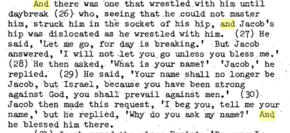The most highly anticipated comics series of the year ends in the biggest way possible—the whole world burns away according to Tyler’s plan, and a new one he never anticipated is conceived. The meek inherit the Earth, and a final showdown proves that, finally, Roland Barthes is right! -- https://en.wikipedia.org/wiki/Fight_Club_2Hm... I wonder what Barthes is right about, precisely. I'll guess that maybe his book S/Z or more broadly his codes might be what is being referred to, but this doesn't resolve the mystery just yet.
Maybe (after looking around a bit more) what Barthes is supposed to be right about is that "there is no one possible meaning but instead 'a plurality of meaning or meaning as plurality'" -- from Searching for Meaning: An Introduction to Interpreting the New Testament, p. 100 -- quoting something from Barthes, but the exact reference is cut off in Google Books. Perhaps the reference is to "L'analyse structurale du récit. A propos d'Actes X-XI" in Recherches de Science Religieuse 58, 1970, pp. 17-37, or Exégèse et Herméneutique, 1971, also reprinted in English translation here (in part).
Indeed, a plurality of meaning sounds somewhat Fight Club-like. And come to think of it...
Perhaps the plural view is stereotyped and made extreme with the remark: "R. Barthes refuses to make any connection between the text and the reality which is imputed to it" (Structural Analysis and Biblical Exegesis: Interpretational Essays, p. 17).
In every new summary -- there are at least five in all -- a new route of destination and of communication is established. The text is, therefor, in its own structure, the center of an intense diffusion of messages. (Structural Analysis and Biblical Exegesis: Interpretational Essays, p. 18)From Searching for Meaning it seems that -- at least potentially -- one of these layers is a phatic code. But as remarked in Structural Analysis and Biblical Exegesis,
The story [Acts] in all the hierarchy of its levels affirms one and the same thing: communication is now possible, grace flows; the Gospel is offered to all.And some terminology is introduced: "Barthes proposes to call diagrammatic such an agreement of the levels."
But whereas the text is structured,
Both the mythic and phatic codes are cultural, and intertextual – they are constituted by “certain types of deja-vu” (Barthes “Valdemar” 191), the already read. -- Essay: A Study in Textual Analysis: Angela Carter’s “The Company of Wolves”Expanding that, I find Roland Barthes (Translated by Donald G. Marshall), “Textual Analysis of a Tale by Edgar Poe,” Poe Studies, June 1977, Vol. X, No. 1, 10:1-12, in which there is the following interesting quote:
The code of communication could also be called the code of the destination. Communication should be understood in a restricted sense. It does not cover all the signification in a text, still less its signifying; it designates only every relation which, in the text, is uttered as an address (this is the situation with the “phatic” code, which bears the burden of accentuating the relation between narrator and reader), or as an exchange (the narrative is exchanged for truth, for life). In sum, communication should here be understood in an economic sense (communication, circulation of commodities).And near the conclusion of this essay, a now very Fight Club-like (and also Bakhtin-like) point: "Undecidability is not a weakness, but a structural condition of narration: there is no univocal determination of the utterance: in an utterance, many codes, many voices, are there, without prevalency... one can no longer point out who speaks and when one only asserts that there begins to speak."




Comments
Post a Comment